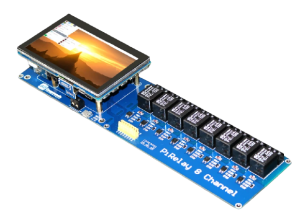PiRelay-8
From SB-Components Wiki
PiRelay 8
The PiRelay 8 is a relay expansion board that can control up to 8 appliances/devices with photo-coupling isolation with load up to 250V AC/7 A, 30V DC/10 A, and a trigger voltage of 3.3 V. It allows users to safely control high voltages or current devices. The PiRelay 8 has enough space for the 4.3" LCD to fit comfortably, allowing the user to operate the device with ease. One of the best features on the PiRelay 8 board is the 5V / 2A USB power port. The Raspberry Pi receives power directly from the PiRelay 8 board.
The PiRelay 8 channel has 8 high-quality relays that can withstand loads up to 250 VAC/7A and 30VDC/10A. We added a safety component called the Optocoupler EL357NC in the PiRelay 8 Channel that functions as a photo coupling isolator in the circuits to ensure safe communication.
Features
- Compatible with Raspberry Pi 4, 3B+, 3, 2, Zero
- Relay Status indicators
- Control through Android App
- Comes with development resources, including examples in python
- Connectivity of the Relay with Raspberry Pi
- Connectivity using the stack method
- Relay pins - COM, NO (Normally Open), and NC (Normally Closed) are available for each Relay.
- Onboard power LED indicator
- Relay control pins selection jumper
- 5V / 2A USB Power Port
Specifications
- Channel - 8 CH
- Operating Voltage - 5V
- Trigger voltage - 3.3V - 5V
- AC Control Voltage - 7A / 250V
- DC Control Voltage - 10A / 30V
- External power supply - USB / Terminal Block
- Dimensions - 267.77 mm - 72.01 mm
Pinout
| Relays | BOARD | BCM |
|---|---|---|
| Relay 1 | 37 | GPIO 26 |
| Relay 2 | 35 | GPIO 19 |
| Relay 3 | 33 | GPIO 13 |
| Relay 4 | 31 | GPIO 6 |
| Relay 5 | 29 | GPIO 5 |
| Relay 6 | 23 | GPIO 11 |
| Relay 7 | 21 | GPIO 9 |
| Relay 8 | 19 | GPIO 10 |
Installation
Python
PiRelay 8 can be used with or without 4.3 inch HDMI LCD, Please follow the following methods for the installation of Pirelay 8.
- Stack Raspberry Pi on 40 Pin header of PiRelay 8 board as shown below.
- Now Power on PiRelay 8 board using USB or Terminal block with 5V/2A power supply,that also turn on the Raspberry Pi as well.
Resources
Github

